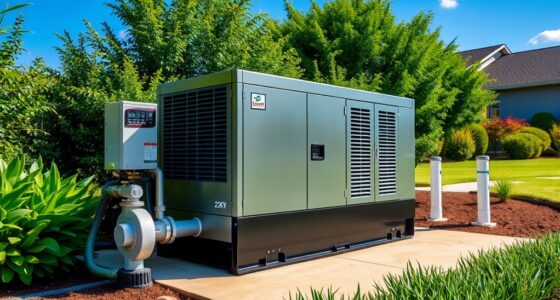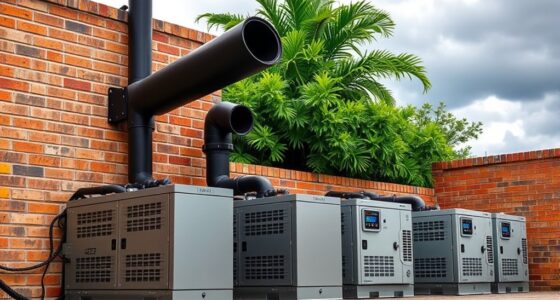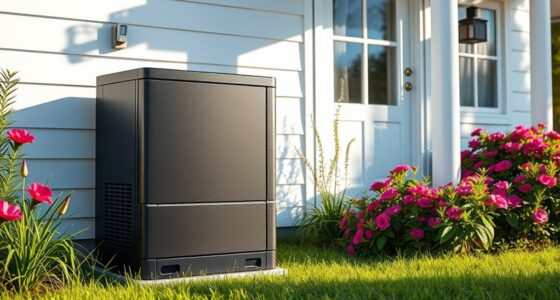Many people misunderstand load shedding, thinking it’s always a sign of a power crisis or that outages are random. In reality, load shedding is a planned, strategic process to balance demand and supply, preventing grid collapse. It involves different stages and scheduling techniques, and isn’t just a fault or failure. Misconceptions about responsibility and the purpose behind load shedding cause unnecessary frustration. Keep exploring to uncover the truth behind these common myths and how it really works.
Key Takeaways
- Load shedding is a planned, controlled process to prevent grid collapse, not a sign of a power crisis or failure.
- Power outages are unplanned disruptions; load shedding involves scheduled, strategic reductions in electricity supply.
- Load shedding durations are typically short-term, lasting minutes to hours, unlike long outages caused by faults or weather.
- Public misconceptions often blame government or power companies solely, overlooking the technical and operational reasons behind load shedding.
- Effective load management includes using renewable energy and backup systems, which many people underestimate or misunderstand.
What Load Shedding Really Means
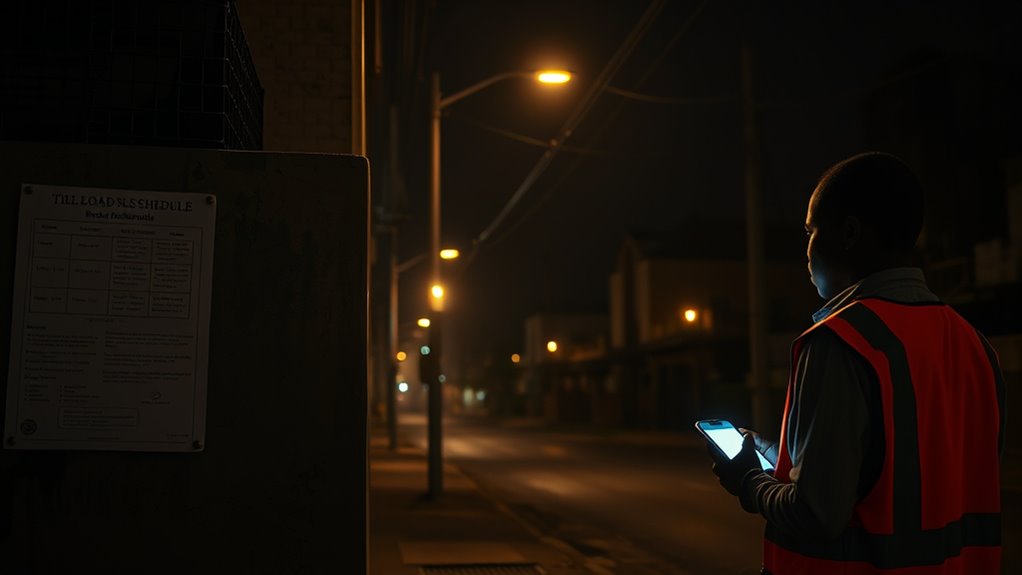
Have you ever wondered what load shedding actually means? It’s a strategy used to prevent power systems from collapsing when demand surpasses supply. During load shedding, authorities temporarily cut electricity to certain areas, balancing the grid’s load. This process helps maintain grid stability, ensuring the entire system doesn’t fail. Renewable sources, like solar and wind, are increasingly integrated into the grid, but their variability can cause fluctuations. Load shedding acts as a safeguard during periods when renewable generation drops or demand spikes unexpectedly. Instead of risking a total blackout, power is deliberately cut in specific zones. This controlled approach keeps the grid stable and allows renewable sources to contribute without overwhelming the system, ensuring a reliable supply for everyone. Additionally, smart grid technologies are being implemented to better manage energy distribution and reduce the frequency of load shedding events.
The Difference Between Power Outages and Load Shedding
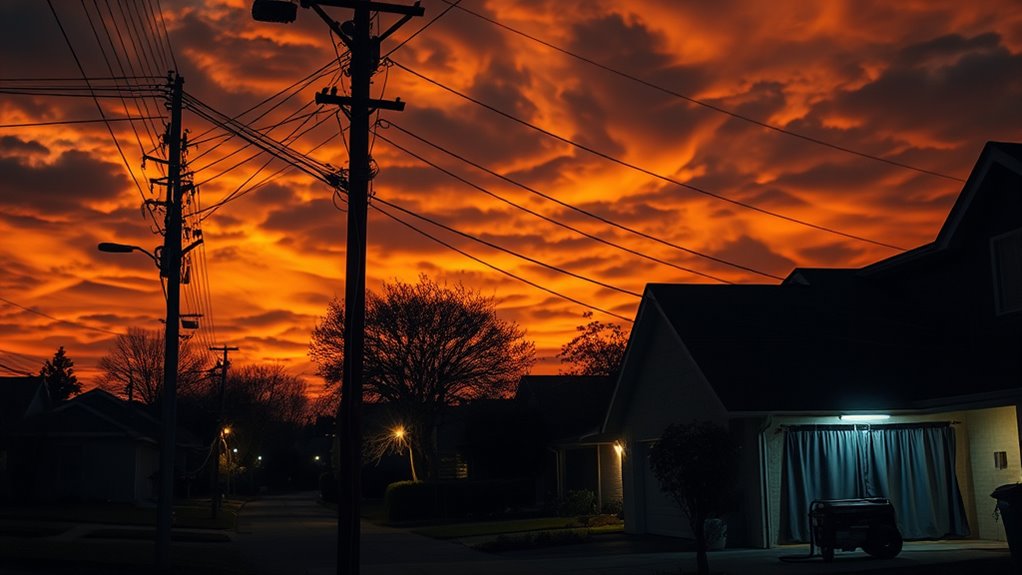
You might think power outages and load shedding are the same, but they serve different purposes. Power outages are unexpected and usually last until repairs are made, while load shedding aims to reduce strain on the grid intentionally. Understanding these differences helps you better prepare for how and when your power might go out. Additionally, high load demands during peak times often trigger load shedding to prevent grid failure.
Power Outages Explained
What exactly distinguishes a power outage from load shedding? A power outage is an unexpected loss of electricity caused by equipment failure, accidents, or severe weather, often lasting hours or days. It’s unplanned and affects a specific area temporarily. Load shedding, on the other hand, is a planned, controlled reduction in power supply to prevent the entire grid from collapsing during peak demand or shortages. It’s part of grid modernization efforts, which aim to make the system more resilient, especially with increasing renewable integration. Power outages happen suddenly and without warning, while load shedding is a deliberate strategy to balance supply and demand. Understanding this difference helps you better grasp how utilities manage our power supply during challenging times.
Load Shedding Purpose
Load shedding serves a critical purpose by helping power utilities manage grid stability during periods of high demand or supply shortages. Unlike power outages, which happen unexpectedly and are often unplanned, load shedding is a controlled process to prevent the entire grid from collapsing. It helps balance supply and demand by temporarily reducing power to certain areas. This process also supports renewable integration by managing fluctuations from sources like wind and solar. Additionally, energy storage systems can be used during load shedding to supply power when needed, reducing the need for widespread outages. Overall, load shedding is a strategic tool that maintains a reliable electricity supply while protecting the grid from overloads and ensuring the continued operation of essential services. Understanding the role of a stable grid is essential for appreciating how load shedding benefits overall energy management.
Duration Differences
While power outages often last for hours or even days, load shedding is typically a short-term measure that lasts only a few minutes to a few hours at most. During these periods, your home may rely on battery backup systems to maintain essential functions, but the power is intentionally cut to reduce overall demand. The duration of load shedding is usually planned and predictable, unlike unexpected power outages caused by faults or storms. If you’ve invested in renewable energy sources like solar panels, you might experience fewer disruptions or be better prepared for load shedding periods. The key difference is that load shedding is controlled and temporary, whereas power outages can be prolonged and unpredictable, often requiring more extensive solutions to restore service. Additionally, modern heat pumps with advanced noise reduction technology can operate more quietly during backup or partial power scenarios, enhancing comfort during these times.
How Load Shedding Schedules Are Determined
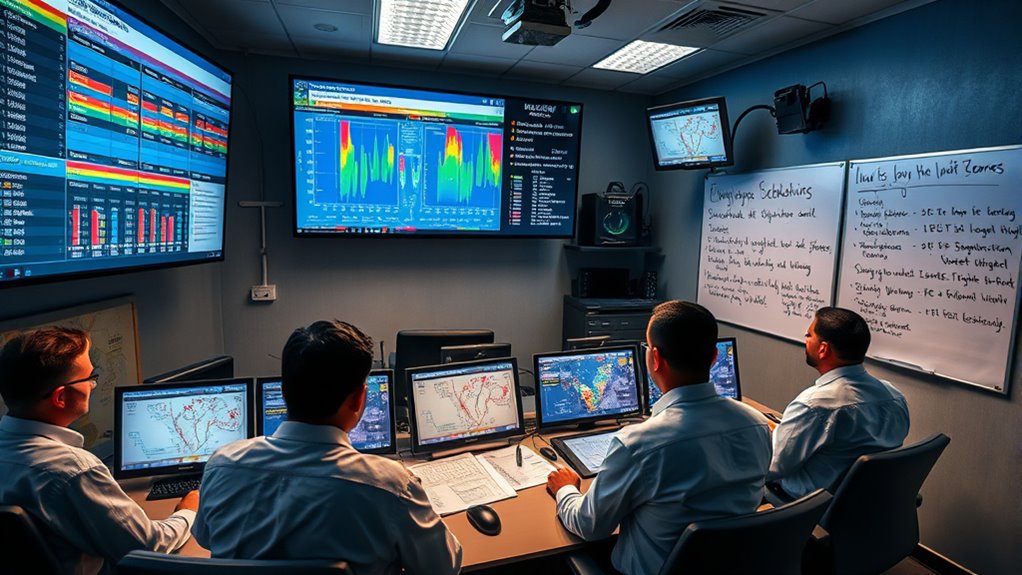
Determining load shedding schedules involves analyzing the demand for electricity against the available supply. Grid operators consider factors like peak usage times, generation capacity, and ongoing renewable integration efforts to maintain grid reliability. They assess how much power is needed and identify areas where outages can minimize disruption while balancing the system. Renewable energy sources, such as wind and solar, influence these decisions because their variability affects supply stability. Operators also factor in the reliability of the existing infrastructure, ensuring that outages are scheduled fairly and strategically. By examining demand patterns and integrating renewable energy insights, they develop schedules that prevent system overloads and protect the grid’s stability. This careful planning helps ensure consistent power delivery and reduces unexpected outages. Load balancing is an essential aspect of this process, ensuring that supply and demand are managed effectively to maintain grid stability.
The Role of Capacity and Demand in Load Shedding
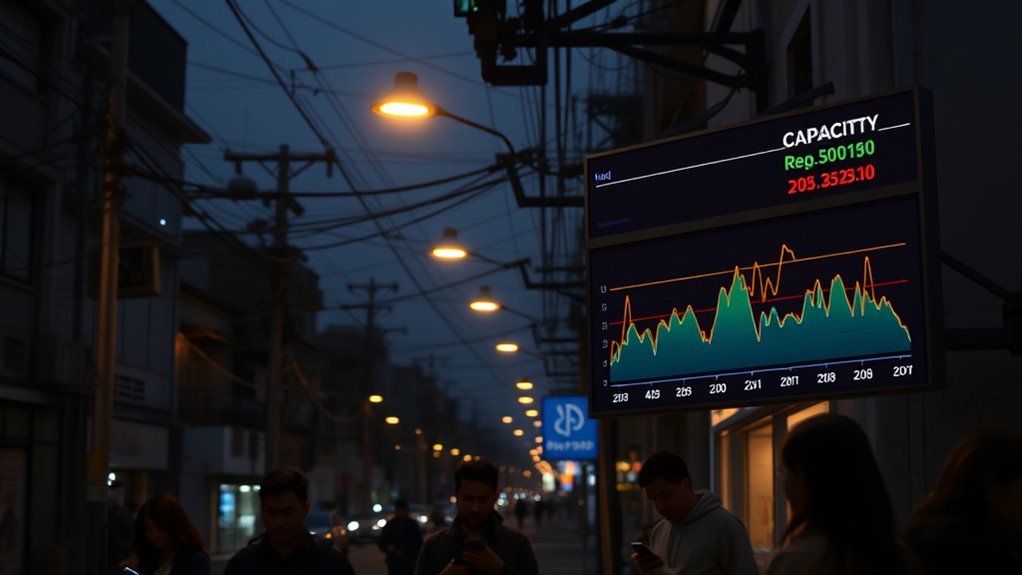
Have you ever wondered how power companies decide when to implement load shedding? It all comes down to the balance between generation capacity and peak demand. Generation capacity is the maximum amount of electricity a power plant can produce, while peak demand is the highest level of electricity consumers need at any given time. When demand approaches or exceeds the available capacity, the system becomes unstable, risking blackouts. To prevent this, utility providers implement load shedding to reduce load and maintain grid stability. By carefully monitoring demand patterns, they can predict when peak demand might threaten the system’s capacity and act accordingly. This balancing act ensures a reliable supply while avoiding overloads, making the concepts of capacity and demand critical to understanding load shedding. Additionally, wall organization systems can be used within homes to manage and optimize energy use, indirectly supporting overall energy efficiency and stability.
Myths About Rotational Power Cuts
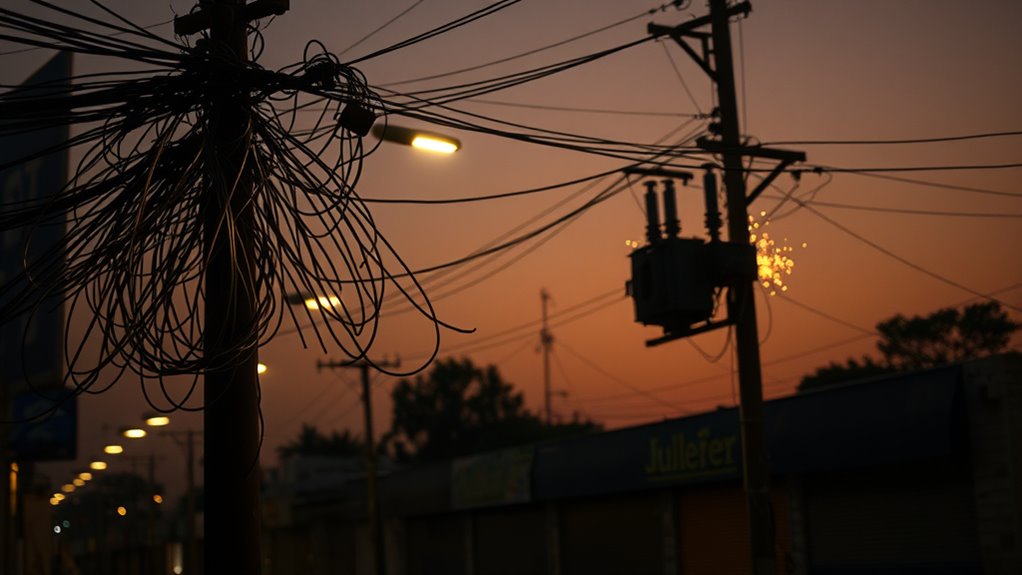
Many people believe that rotational power cuts are random or unnecessary, but this isn’t true. They are carefully planned to maintain grid stability and prevent total blackouts. Here’s what you should know: 1. They balance demand and supply, ensuring the grid remains stable during periods of low renewable energy output. 2. Rotational cuts help avoid overloading transmission lines, reducing the risk of damage and outages. 3. They give grid operators time to integrate renewable energy sources effectively, smoothing fluctuations. 4. These cuts are part of a strategic approach to prevent widespread failures, rather than a sign of mismanagement. Understanding this helps you see that rotational power cuts are essential for maintaining a reliable, sustainable energy system. Proper planning is crucial for effective load management and grid resilience.
The Impact of Load Shedding on Daily Life

How does load shedding affect your daily routine? It disrupts your schedule, forcing you to adapt quickly. Power outages can interrupt work, slow down household chores, and spoil meals. To stay prepared, many turn to alternative energy sources like generators or solar panels, ensuring essential appliances run smoothly. Household preparedness becomes vital during these times, so having flashlights, batteries, and non-perishable food stocked up helps you manage the inconvenience. Without consistent electricity, your daily activities—whether working from home, cooking, or relaxing—are affected. Load shedding emphasizes the importance of planning ahead and investing in reliable backup solutions. Staying informed about schedules and maintaining household readiness can minimize disruptions and keep your daily life running more smoothly despite these power challenges. Additionally, understanding home maintenance tips can help you better manage your living space during extended outages.
Why Load Shedding Is Not Always a Sign of a Power Crisis

Not all load shedding indicates a power crisis; some are scheduled to balance demand. Emergency stops happen unexpectedly to prevent overloads, but they’re not always a sign of trouble. Understanding strategic load management shows how utilities control supply without a crisis. Maximize space and organization techniques can be applied to manage and optimize energy consumption and resource allocation effectively.
Scheduled vs. Emergency Stops
While load shedding often signals a power crisis, it’s important to understand that not all stops are the same. Scheduled stops are planned in advance, allowing utility companies to manage demand and perform real-time adjustments smoothly. Emergency stops, on the other hand, happen unexpectedly due to system faults or safety concerns, requiring immediate action and backup plans. Recognizing this difference helps you avoid panic during routine outages. Here are key points to consider:
- Scheduled stops are part of a proactive strategy to balance supply and demand.
- Emergency stops are reactive, addressing unforeseen issues quickly.
- Scheduled outages enable better communication and preparation.
- Emergency stops demand rapid response to prevent system failure.
- Understanding the load shedding process can help you stay informed and prepared.
Understanding these distinctions clarifies that load shedding isn’t always a sign of a power crisis but often a necessary, carefully managed process.
Strategic Load Management
Have you ever wondered why utility companies schedule load shedding even when the power grid isn’t failing? This is part of strategic load management, a deliberate approach to balance supply and demand. Utilities often use battery backup systems to ensure critical services stay online during outages, reducing the need for widespread blackouts. They also incorporate renewable energy sources, like solar and wind, to diversify power supplies and lessen reliance on traditional generation. Strategic load management helps prevent grid overloads and maintains stability, especially during peak times. It’s not always about a power crisis but about optimizing resources and ensuring reliable service. By carefully planning load shedding, utilities protect their infrastructure and support sustainable energy integration, making the process more controlled and less disruptive for consumers.
Understanding the Load Shedding Stages and Their Significance

Ever wondered how load shedding stages determine the severity and timing of power outages? These stages guide grid operators to balance supply and demand, impacting grid resilience and energy efficiency. Each stage reflects different levels of strain on the system:
- Stage 1: Minor outages, mainly during peak demand.
- Stage 2: Moderate outages to prevent grid overload.
- Stage 3: Severe outages to protect infrastructure.
- Stage 4: Critical, widespread outages, risking grid collapse.
Understanding these stages helps you anticipate disruptions and supports efforts to improve grid resilience. By minimizing the impact of each stage, you contribute to a more stable power system. Recognizing their significance enables better planning and promotes energy efficiency during outages.
The Connection Between Load Shedding and Energy Conservation

Load shedding and energy conservation are closely linked, as effective conservation efforts can reduce the frequency and duration of outages. When you use energy wisely, you’re easing the demand on the grid, which helps maintain grid stability. This is especially important as renewable integration increases; renewables like solar and wind depend on a stable grid to operate efficiently. By conserving energy, you decrease the strain on power plants and transmission lines, making it easier to balance supply and demand. This, in turn, reduces the need for load shedding. Your efforts in turning off unused devices, optimizing energy use, and supporting renewable sources contribute directly to a more reliable, resilient energy system. Ultimately, conservation benefits everyone by helping to prevent outages and promote sustainable energy use.
Common Misconceptions About Who Is Responsible for Load Shedding
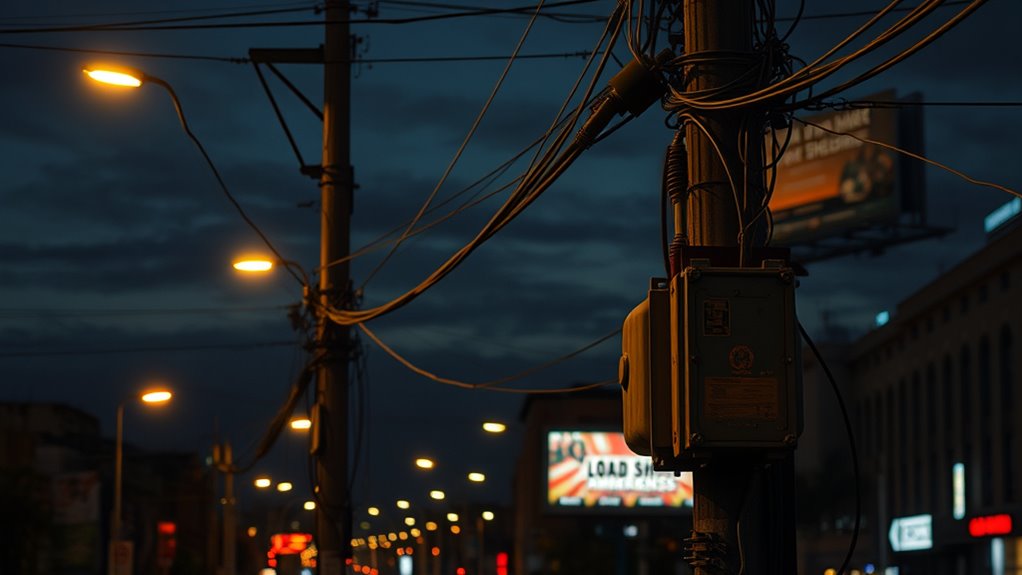
Many people mistakenly believe that load shedding is entirely the utility company’s fault, but it’s a shared responsibility. The government also plays a role in managing and planning energy supply, which isn’t always clear. This confusion often leads to misunderstandings about who really controls and is accountable for load shedding.
Power Utility Role
Have you ever wondered who is truly responsible for implementing load shedding? The power utility plays a central role, but many misconceptions exist. They manage:
- Maintaining grid stability through renewable integration, which helps balance supply and demand.
- Modernizing infrastructure with grid modernization efforts to prevent outages.
- Balancing supply shortages by scheduling load shedding strategically.
- Ensuring communication with consumers about outages and recovery plans.
While the utility controls these actions, load shedding isn’t solely their decision—it’s a response to broader factors like generation capacity and demand. Their role involves adapting to evolving energy sources and upgrading systems, but responsibility also involves coordination with government policies and consumer behavior. Understanding this helps clarify who manages load shedding and why it occurs.
Government’s Responsibility Scope
While it’s common to assume that the government is solely responsible for managing load shedding, the reality is more nuanced. The government’s role primarily involves setting policies through legislative authority to guarantee the stability of the power supply. These policies guide how load shedding is implemented and prioritized, but they don’t directly control daily operations. Instead, government agencies oversee regulatory frameworks, allocate resources, and establish guidelines for utility companies. The utility companies then carry out the actual load shedding based on technical assessments and operational needs. So, while the government’s responsibility includes creating the policy environment, the day-to-day management and execution rest with utility providers and industry stakeholders. This shared scope of responsibility often leads to misunderstandings about who’s ultimately accountable.
Public Misunderstanding Prevails
Public misconceptions about who is responsible for load shedding often lead to confusion and misplaced blame. Many people fall prey to public misunderstanding fueled by misinformation spread via social media and word of mouth. This can obscure the real causes behind power outages. To clarify, here are common misconceptions:
- Blaming the government solely for load shedding.
- Assuming power companies intentionally cut electricity.
- Believing load shedding is a sign of national failure only.
- Thinking consumers can prevent outages by conservation alone.
These misconceptions hinder understanding and foster unwarranted anger. Recognizing that load shedding is a complex process involving multiple factors helps dispel misinformation spread and promotes more informed discussions about energy management. Remember, responsibility isn’t always as straightforward as it appears.
Frequently Asked Questions
How Can Consumers Prepare for Load Shedding Effectively?
You can prepare for load shedding by practicing energy conservation, which helps reduce your power usage during outages. Invest in backup power solutions like generators or battery systems to keep essential devices running. Make a plan to charge devices ahead of time and keep flashlights, candles, and other supplies handy. Staying aware of load shedding schedules also allows you to plan activities accordingly, minimizing disruptions and ensuring you stay comfortable and connected.
What Technological Solutions Can Reduce Load Shedding Impacts?
Think of technology as your shield against load shedding. Implementing smart grid systems allows you to manage energy flow efficiently, reducing outages. Coupling this with energy storage solutions, like batteries, acts as a reservoir, releasing power when demand peaks. These tools work together to smooth the energy turbulence, minimizing disruptions. Embracing such innovations can turn load shedding from a crisis into a manageable challenge, keeping your lights steady and your life uninterrupted.
Are There Environmental Effects Linked to Load Shedding Practices?
Yes, load shedding can have environmental effects, especially if it relies heavily on fossil fuels. When the grid isn’t resilient, power outages increase reliance on diesel generators, which emit greenhouse gases. By integrating renewable sources like solar and wind, you can reduce these impacts, improve grid resilience, and promote cleaner energy. This shift helps protect the environment while ensuring a more stable power supply for everyone.
How Do Load Shedding Policies Vary Globally?
You’ll notice that load shedding policies vary globally depending on each country’s energy infrastructure and priorities. Some nations focus on renewable integration to reduce reliance on fossil fuels, while others implement policy reforms to improve grid stability. In developed countries, policies often emphasize sustainability, whereas in developing regions, the focus may be on managing demand efficiently. Your understanding of these differences helps you see how governments adapt strategies to their unique energy challenges.
What Are the Long-Term Solutions to Eliminate Load Shedding?
To eliminate load shedding long-term, you should focus on renewable integration and grid modernization. By investing in renewable energy sources like solar and wind, you reduce reliance on fossil fuels and create a more sustainable power supply. Modernizing the grid with smart technology improves efficiency, balances demand, and quickly responds to fluctuations. These strategies together help build a resilient, reliable energy system that minimizes the need for load shedding over time.
Conclusion
Think of load shedding as a traffic cop guiding cars through a busy intersection. It’s not chaos or failure, but a careful dance to keep everything running smoothly. By understanding the real reasons behind it, you become a better driver in this energy maze. When you see the lights flicker, remember—you’re part of a larger system working behind the scenes to keep the flow moving. Stay informed, stay patient.



